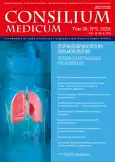Congenital laryngeal anomalies in childhood
- Authors: Stepanova Y.E.1
-
Affiliations:
- Saint-Petersburg Research Institute of Ear, Throat, Nose and Speech
- Issue: Vol 26, No 9 (2024): Otorhinolaryngology and pulmonology
- Pages: 605-610
- Section: Articles
- URL: https://bakhtiniada.ru/2075-1753/article/view/277096
- DOI: https://doi.org/10.26442/20751753.2024.9.202901
- ID: 277096
Cite item
Full Text
Abstract
Background. Diagnosis of congenital malformations of the larynx in children is a difficult task for otorhinolaryngologists. The development and implementation of video endoscopic techniques has made a significant contribution to the understanding of anatomical changes in the larynx during CPR.
Aim. To study the clinical manifestations of congenital malformations in children over 6 years of age.
Materials and methods. Eighty three (100%) children with laryngeal malformations aged 6 to 18 years (10.1±0.6) were examined, who applied to the phoniatric department of the Saint-Petersburg Research Institute of Ear, Throat, Nose and Speech from 2002 to 2023. The number of boys is 39 (47%) people, girls – 44 (53%) people. The maximum incidence of children of both sexes was observed at the age of 8–12 years.
Results. It should be noted that in all patients, this pathology was detected for the first time when contacting a phoniatrist. Dysphonia is expressed from birth in 30 (36%) patients. Three children also complained of difficulty breathing from birth. In 15 (18%) children, the voice remained normal. The purpose of their visit is a preventive examination. Dysphonia in the remaining 38 (46%) children appeared during increased vocal load. The structures of the congenital malformations are presented as follows: tissue defects 36 (43%) people, organ defects 34 (41%) people, combined organ-tissue defects 10 (12%) people, neurogenic defects 3 (4%). None of the examined patients had congenital tumors. Hypoplasia or grooves of the vocal folds were diagnosed in 20 (23%) cases in the group of tissue VPR. Nine (11%) patients suffered from arytenoid cartilage dyschronia, and 7 (8%) patients suffered from dysplasia. Organ defects were represented by dystopia or “crossing” of the arytenoid cartilages in 29 (35%) and epiglottis dysgenesis in 5 (6%). Based on the clinical and endoscopic picture of the larynx, we have identified two degrees of dystopia. The first degree was diagnosed in 18 (21%), and the second in 11 (13%) children.
Conclusion. Patients with both tissue and organ cysts are characterized by the formation of nodules, cysts, mucosal hyperplasia, fusiform thickened edge of the vocal cord, chronic laryngitis, hypertrophy of vestibular folds. These changes should be considered as a compensatory and adaptive mechanism in conditions of forced vocalization due to anatomical changes in the larynx.
Full Text
##article.viewOnOriginalSite##About the authors
Yulia E. Stepanova
Saint-Petersburg Research Institute of Ear, Throat, Nose and Speech
Author for correspondence.
Email: julia.stepanov@yandex.ru
D. Sci. (Med.), Assoc. Prof.
Russian Federation, Saint PetersburgReferences
- Цветков Э.А. Пороки гортани и трахеи у детей. СПб.: Сотис-Лань, 1999 [Tsvetkov EA. Poroki gortani i trakhei u detei. Saint Petersburg: Sotis-Lan’, 1999 (in Russian)].
- Захарова М.Л., Павлов П.В. Врожденные пороки развития гортани у детей. Российская оториноларингология. 2017;1:31-5 [Zakharova ML, Pavlov PV. Congenytal larynx diseases in children. Rossiiskaia Otorinolaringologiia. 2017;1:31-5 (in Russian)]. doi: 10.18692/1810-4800-2017-1-31-35
- Мутовин Г.Р. Клиническая генетика. Геномика и протеомика наследственной патологии: учеб. пособие. 3-е изд., перераб. и доп. М.: Гэoтар-Медиа, 2010; c. 832 [Mutovin GR. Klinicheskaia genetika. Genomika i proteomika nasledstvennoi patologii: ucheb. posobiie. 3-e izd., pererab. i dop. Moscow: GeotarMedia, 2010; p. 832 (in Russian)].
- Степанова Ю.Е. Дисфонии у детей и подростков. Российская оториноларингология. 2004;6:41-4. Режим доступа: https://www.elibrary.ru/item.asp?id=34879108. Ссылка активна на 02.07.2024 [Stepanova YuE. Dysphonia in children and adolescents. Rossiiskaia Otorinolaringologiia. 2004;6:41-4. Available at: https://www.elibrary.ru/item.asp?id=34879108. Accessed: 02.07.2024 (in Russian)].
- Степанова Ю.Е., Цветков Э.А. Врожденные пороки развития гортани у детей и подростков. Российская оториноларингология. 2003;5:198-200. Режим доступа: https://www.elibrary.ru/item.asp?id=34879095. Ссылка активна на 02.07.2024 [Stepanova YuE, Tsvetkov EA. Congenital anomalies of the larynx in children and adolescents. Rossiiskaia Otorinolaringologiia. 2003;5:198-200. Available at: https://www.elibrary.ru/item.asp?id=34879095. Accessed: 02.07.2024 (in Russian)].
- Cotton RT, Prescott CAJ. Congenital аnomalies of the larynx. In: Practical Pediatric Otolaryngology. 1st ed. Philadelphia: Lippincott-Raven Publishers, 1999.
- Berkowitz RG. Natural history of tracheostomy-dependent idiopathic congenital bilateral vocal fold paralysis. Otolaryngol Head Neck Surg. 2007;136(4):649-52. doi: 10.1016/j.otohns.2006.11.050
- Ahmad SM, Soliman AMS. Congenital anomalies of the larynx. Otolaryngol Clin North Am. 2007;40(1):177-91.
- Hasniah AL, Asiah K, Mariana D. Congenital bilateral vocal cord paralysis. Med J Malaysia. 2006;61(5):626-9.
- Nicollas R, Triglia JM. The anterior laryngeal webs. Otolaryngol Clin North Am. 2008;41(5):877-88.
- Захарова М.Л., Павлов П.В., Алексеева Л.Б. Врожденная киста гортани у младенца. Российская оториноларингология. 2016;1:117-20 [Zakharova ML, Pavlov PV, Alekseeva LB. Congenital laryngeal cyst in an infant. Rossiiskaia Otorinolaringologiia. 2016;1:117-20 (in Russian)]. doi: 10.18692/1810-4800-2016-1-117-120
- Sato K, Hirano M. Electron microscopic investigation of sulsus vocalis. Ann Otol Rinol Laryngol. 1998;107(1):56-60.
- Abitbol J. Atlas of laser voice surgery. San Diego: Singular, 1995.
- Василенко Ю.С. Голос. Фониатрические аспекты. М.: Дипак, 2013 [Vasilenko YuS. Golos. Phoniatricheskiie aspekty. Moscow: Dipak, 2013 (in Russian)].
- Степанова Ю.Е., Готовяхина Т.В., Махоткина Н.Н. Важность своевременной диагностики заболеваний гортани при первичном осмотре врачом-оториноларингологом. Медицинский совет. 2018;(20):58-64 [Stepanova YuE, Gotovyakhina TV, Makhotkina NN. Importance of timely diagnosis of diseases of the larynx during initial examination performed by an otorhinolaryngologist. Meditsinskii Sovet. 2018;(20):58-64 (in Russian)]. doi: 10.21518/2079-701X-2018-20-58-64
- Hirano M, Bless DM. Videostroboscopic examination of the larynx. San-Diego: Singular, 1993.
- Степанова Ю.Е. Инновационные эндоскопические технологии в диагностике заболеваний гортани у взрослых и детей. Вестник оториноларингологии. 2020;85(6):41-5 [Stepanova YuE. Innovative endoscopic technologies in the diagnosis of laryngeal diseases in adults and children. Vestnik Otorinolaringologii. 2020;85(6):41-5 (in Russian)]. doi: 10.17116/otorino20208506141
Supplementary files















